When the Cloud Goes Down: How Bare Metal Keeps You Online 20 Oct 8:02 AM (3 days ago)
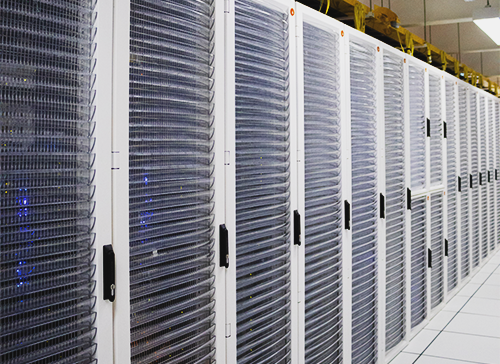
If you tried to use Snapchat, order food on the McDonald’s app, or trade on Robinhood this morning, you likely encountered an error message. The culprit wasn’t a failure within those individual companies but a widespread outage at Amazon Web Services (AWS), the cloud computing giant that powers a significant portion of the internet.
For hours, services used by millions globally were inaccessible. Some are still down as of this writing. Even Amazon’s own Ring and Alexa platforms weren’t immune. This is yet another critical lesson in infrastructure risk management: putting all your eggs in a shared, virtualized basket introduces a single point of failure that can cripple your business.
The Hidden Risk of the Public Cloud
Public cloud platforms like AWS, Azure, and Google Cloud are marvels of modern engineering, offering immense scalability by virtualizing resources across vast pools of shared hardware. But that same interdependence is also their Achilles’ heel.
A software bug, misconfiguration, or regional network issue within a shared environment can cause a cascading failure that takes thousands of unrelated businesses offline in an instant, as we are seeing today.
Even if your own application is flawless, it’s still subject to the noisy neighbor effect. Think of it as renting an apartment in a skyscraper: if the building’s power grid fails, every tenant goes dark, no matter how well you’ve managed your own unit.
Reclaim Control and Guarantee Uptime with Bare Metal
Unlike the multi-tenant cloud model, bare metal servers provide dedicated, single-tenant environments — your own isolated hardware, optimized for reliability and performance. Moving to bare metal directly addresses the weaknesses exposed by today’s AWS outage:
-
Eliminate Noisy Neighbor Risk: You’re not sharing CPU, memory, or disk I/O with anyone. Your resources are reserved, predictable, and unaffected by other tenants’ workloads.
-
Reduce Complexity and Failure Points: Cloud environments are stacked with layers — control planes, hypervisors, APIs — each a potential point of failure. Bare metal is simpler by design. Fewer layers mean fewer ways for things to go wrong.
-
Predictable Performance for Mission-Critical Workloads: For databases, AI inference, or latency-sensitive applications, raw hardware access ensures maximum throughput and reliability.
-
Compliance and Security: Bare metal offers clear physical boundaries and easier auditing for HIPAA, PCI DSS, or other strict frameworks. You know exactly where your data lives — and who can touch it.
Building a Smarter Hybrid Infrastructure
Public cloud has its place. For elastic, burstable, or non-critical workloads, cloud platforms deliver flexibility. But for core systems — databases, production applications, payment processing — reliance on a single cloud provider is a single point of failure.
A hybrid strategy solves this:
-
Use bare metal for the foundation — where uptime, performance, and compliance matter most.
-
Use cloud services for what they do best — scaling dev/test environments and short-term compute bursts.
This multi-domain approach creates true resilience: if one system falters, your enterprise remains online.
Don’t Let Your Business Be the Next Headline
Today’s AWS outage proves once again that even the biggest providers aren’t immune to failure. The question isn’t if another outage will happen, it’s when.
At HostDime, we build global, Tier IV-certified data centers designed for fault tolerance and uptime independence. Our bare metal servers give enterprises total control, consistent performance, and the confidence that your business won’t go dark when the cloud does.
We offer both self-managed and fully managed bare metal servers in strategic locations around the world — so you can choose the level of control, support, and scalability that fits your operations best.
Ready to architect for true reliability? Contact our Data Center Infrastructure solutions team today to discuss how HostDime’s global bare metal platform can become the bedrock of your uptime.
The post When the Cloud Goes Down: How Bare Metal Keeps You Online appeared first on HostDime Blog.
InterNexa Launches PoP at HostDime’s Bogotá, Colombia Data Center 30 Sep 7:06 AM (23 days ago)

Bogotá, Colombia – September 30, 2025 – HostDime, a global hyper-edge data center company, announced that InterNexa — one of the largest IP networks and fiber operators in Colombia — has deployed a Mega PoP inside HostDime’s Tier IV certified data center in Bogotá, codenamed Nebula.
InterNexa operates an extensive 32,000+ km fiber optic network throughout Colombia, and with its main backbone now on-net, Nebula is established as a premier interconnectivity hub. The facility provides global and national fiber carriers, cloud providers, content providers, AI workloads, ISPs, OTTs, peering exchanges, and enterprises with ultra-low latency, high-capacity access into the entire Colombian market. This positions Nebula as one of the most interconnected data centers in the country. Customers inside Nebula can now seamlessly tap into InterNexa’s network, while InterNexa’s clients gain access to Nebula’s next-generation Tier IV digital infrastructure to expand in the Colombian market.
This alliance also connects HostDime’s 70,000-square-foot, purpose-built Tier IV hyper-edge data center directly to InterNexa’s ecosystem of 16 interconnected facilities across Colombia. By leveraging InterNexa’s redundant ring topology and major peering points, HostDime clients in Nebula gain a significant advantage through direct connectivity into InterNexa’s network for accelerated content and workload delivery throughout the region.
“Having InterNexa on-net is a major milestone for HostDime Colombia and for Colombia’s digital infrastructure,” said Manny Vivar, Founder and CEO of HostDime. “When we set out to build Nebula, our vision was to create next-gen digital infrastructure that would foster partnerships like this — building an ecosystem that benefits all stakeholders, from cloud and content providers to AI inferencing workloads and fiber carriers. I encourage everyone to visit Nebula and experience firsthand what a purpose-built, next-generation, highly connected data center feels and looks like. You will leave inspired.”
HostDime’s Nebula Data Center, located in North Bogotá (Tocancipá), is one of the only Uptime Institute Tier IV certified facilities in Colombia, backed by a 100% uptime SLA. It features 6 MW of power capacity, rack densities up to 50 kW, and more than 10 fiber carriers already on-net. The facility is sustainably designed, holding EDGE Building environmental certifications. Its carrier-neutral operation, combined with next-gen digital infrastructure capabilities, offers Nebula occupants an unmatched environment to thrive in the Colombian market.
Beyond the enterprise market, this network expansion also improves the everyday digital experience for Colombian end users. With Nebula as a direct node on InterNexa’s backbone, streaming services, cloud apps, and online platforms can deliver content closer to end users, enabling faster performance, smoother gaming, and more reliable access without international backhauling.
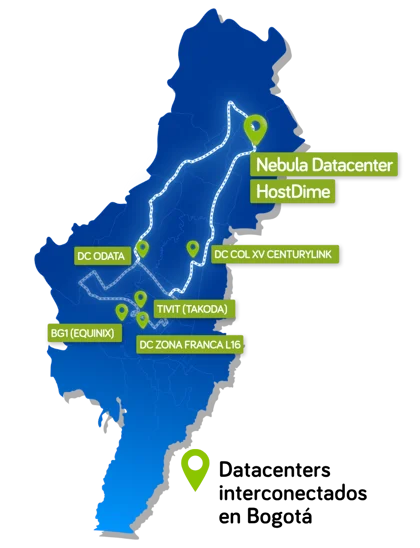
Colombia is rapidly establishing itself as a regional technology hub, with demand for reliable, low-latency infrastructure surging across financial services, government, energy, media, and AI applications. AI workloads in particular require both high availability and ultra-fast inferencing at the edge, making Nebula’s Tier IV digital infrastructure and direct fiber connectivity a critical advantage for enterprises building next-generation services in Colombia. By serving as a strategic interconnection point within Bogotá’s digital ecosystem, Nebula empowers enterprises to scale while contributing to the country’s economic and technological growth.
This InterNexa partnership reinforces HostDime’s vision to design, build, and operate next-generation data centers in key emerging and underserved markets, providing global clients with the edge infrastructure needed for growth and positioning HostDime as a key driver of Colombia’s digital future.
About HostDime
HostDime is a hyper-edge, global data center company operating our owned purpose-built data center facilities in Mexico, Brazil, Colombia, and our flagship facility in Florida, USA, and with owned networks in UK and India. Our mission is to design, build, and operate purpose-built, next-gen data center facilities at the global edge. We offer an array of core digital infrastructure products and services including colocation (private data center suites, cages, racks), interconnection (cross-connects, peering, transit), Hardware-as-a-Service (bare metal servers, lease-to-own servers, hardware procurement), cloud infrastructure (private, hybrid, multi-cloud), and managed services (server management, remote hands, smart hands).
About InterNexa
We are InterNexa, wholesaler of connectivity, infrastructure and technology services in Latin America. With 25+ years of experience, we operate 32,000+ km of optical fiber and more than 40 interconnected datacenters in Colombia and Peru. We are an ISA company, a multi-Latin company with more than 57 years connecting people and communities in 6 Latin American countries and part of the Ecopetrol Group. We provide specialized technological solutions for governments, ISPs, telecommunications operators, OTTs and the mining and energy sector. Through our network infrastructure, ecosystem of interconnected datacenters and managed security services, we maximize operational efficiency, accelerate digital growth and strengthen our clients’ business continuity.
The post InterNexa Launches PoP at HostDime’s Bogotá, Colombia Data Center appeared first on HostDime Blog.
How End-to-End Encrypted Backups Safeguard Your Enterprise Data 18 Sep 7:42 AM (last month)
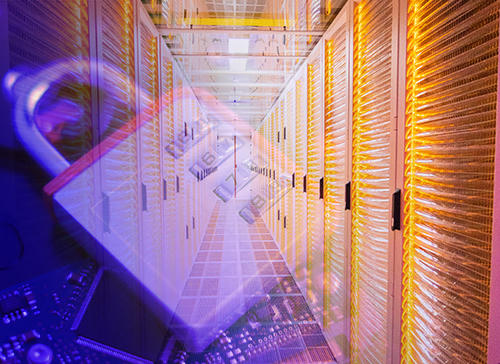
Enterprise data is under siege. From ransomware campaigns to insider threats to regulatory scrutiny, the stakes have never been higher. One breach can grind operations to a halt, drain revenue, and erode customer trust overnight. That’s why enterprise data protection isn’t just about having backups, it’s about securing those backups with end-to-end encryption.
HostDime’s Backup as a Service (BaaS), powered by industry leader Veeam, delivers this critical safeguard, ensuring that your most valuable assets are protected whether in transit, at rest, or during recovery.
Why Backup Encryption Matters
A backup is only as strong as its weakest link. If attackers or unauthorized users gain access to your backup repository, they can steal, corrupt, or even encrypt your data before you get the chance to restore it. This isn’t hypothetical, ransomware gangs increasingly target backups first to prevent recovery.
Encryption neutralizes this risk by scrambling data into unreadable form that can only be unlocked with the correct keys. Even if your backup files are intercepted or stolen, they remain useless without authorization.
End-to-End Protection in Practice
HostDime BaaS secures your data with:
-
Encryption in transit: All backup data moves across a secure SSL connection, preventing interception during transfer.
-
Encryption at rest: Files stored in HostDime’s enterprise-class repositories remain encrypted, even within the data center.
-
Encryption during recovery: Data stays protected throughout the restore process until it is safely back in your environment.
This “always-on” model ensures there are no gaps in your security posture.
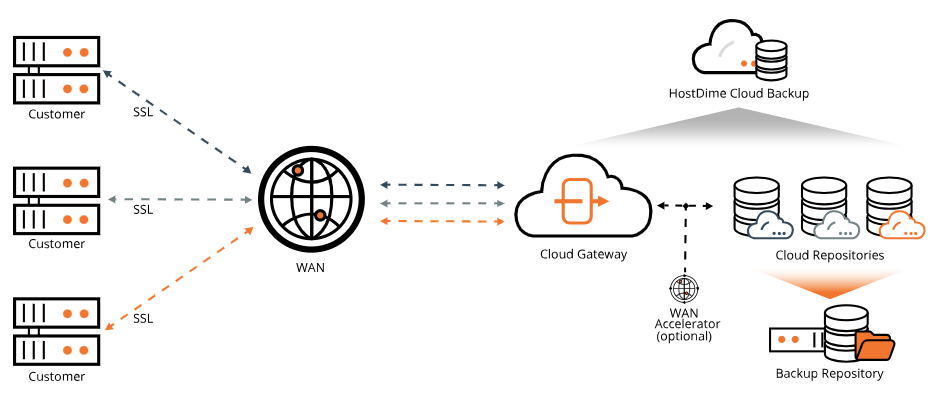
Defense Against Ransomware and Breaches
Encryption is a powerful line of defense, but it’s even more effective when combined with a modern backup architecture:
-
Immutable backups: Prevent data from being altered or deleted by malicious actors.
-
Forever incremental backups: Reduce attack surfaces by only capturing changes instead of creating full, easily targeted files.
-
WAN-accelerated copy jobs: Maintain secure, redundant off-site copies to ensure rapid recovery from any location.
Together, these features make HostDime’s BaaS a proactive security strategy, not just a disaster recovery plan.
Protect Your Enterprise Data Today
End-to-end encryption turns backups into a secure vault that only you can open. It’s a safeguard against today’s most dangerous threats and tomorrow’s compliance challenges.
HostDime’s Backup as a Service makes enterprise data protection simple and affordable. Each plan includes a Veeam backup agent installed on your server and 50 GB of backup storage.
-
Bare Metal Server: $35/month
-
Cloud Server: $35/month
-
Custom Configuration: Add 50 GB blocks for just $5/month each
Protect your business before disaster strikes. Chat with HostDime’s Data Center Infrastructure Specialists today to build your customizable backup solution.
The post How End-to-End Encrypted Backups Safeguard Your Enterprise Data appeared first on HostDime Blog.
Beyond Hyperscale: Why AI Inferencing Belongs in Global Edge Data Centers 11 Sep 9:18 AM (last month)
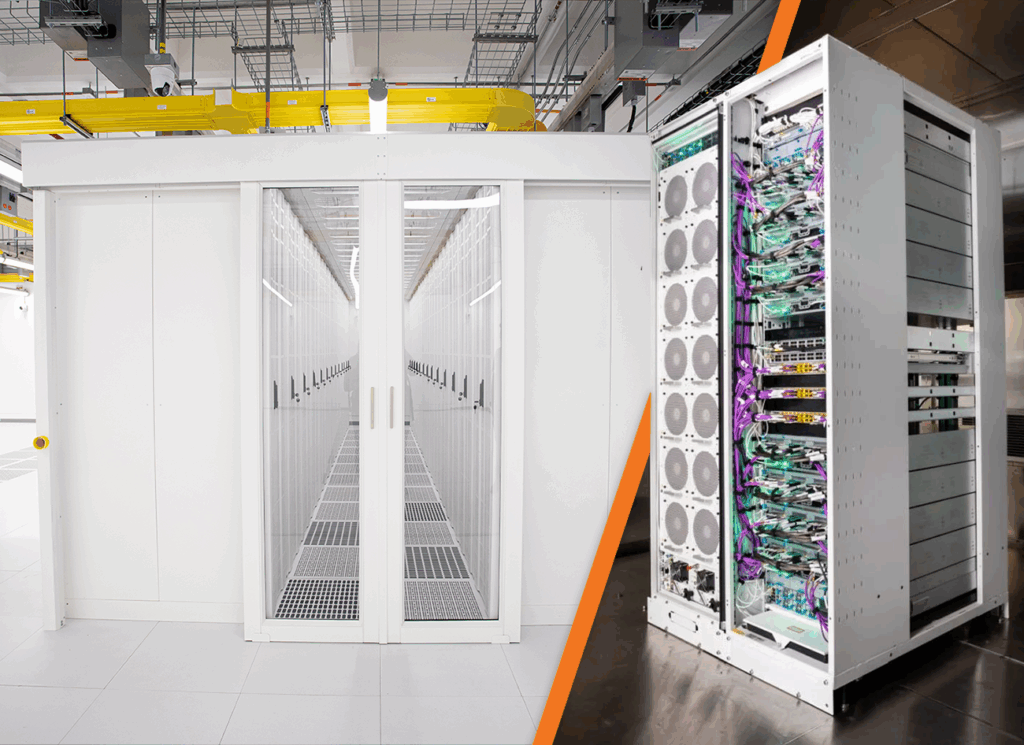
That instant when your phone unlocks with a glance. The moment your streaming service recommends a show you love. The split-second a self-driving car identifies a hazard. This is AI inferencing in action.
Inferencing is the final act where a trained AI model applies everything it has learned to make real-time decisions on new data. Training those models in massive hyperscale clouds gets the headlines, but the real challenge — and opportunity — for businesses today is delivering that intelligence instantly.
Why Hyperscale Alone Falls Short
The old model of sending every data request back to a centralized hyperscale or public cloud data center is cracking under pressure. Latency, bandwidth costs, and privacy risks add up quickly when billions of real-time inferences must happen every second.
Hyperscale clouds are still the best place to train large AI models on vast datasets. But inferencing, where customer experiences are shaped, needs a different home. And that home is the global edge data center.
The Three Homes of a Thinking AI
AI inference is flexible, but its performance depends entirely on its location.
-
The Cloud: ideal for training and for workloads that need centralized global data, like fraud detection across millions of transactions.
-
The Device: best for ultra-local, offline tasks on smartphones, cameras, or wearables.
-
The Global Edge Data Center: the emerging sweet spot for enterprise AI inferencing. By deploying GPUs in colocation facilities strategically located in fast-growing metros outside Tier 1 hubs, enterprises get the balance of speed, privacy, and scalability the cloud alone can’t deliver.
This is not just an architectural tweak — it’s a competitive necessity. When milliseconds matter, the global edge is the only way to keep up.
Why AI Inferencing Colocation at the Global Edge Wins
Placing your GPU servers in purpose-built global edge colocation facilities delivers what hyperscale clouds simply cannot:
-
Unbeatable Speed: Sub-10 millisecond latency by processing data close to where it’s generated.
-
Ironclad Privacy & Compliance: Keep sensitive healthcare, finance, or proprietary data inside certified facilities instead of routing across continents.
-
Predictable Control: Choose your own GPUs, configure your stack, and avoid the lock-in of cloud marketplaces.
-
Cost-Effective Scaling: Expand rack by rack, only paying for what you use, with no surprise egress fees.
HostDime: Powering AI at the Global Edge
At HostDime, we are building the next generation of purpose-built, global edge data centers designed for AI inferencing. With facilities in Orlando, Guadalajara, João Pessoa, Bogotá, and more, we’re placing enterprise AI infrastructure closer to where people actually live, work, and create.
We provide the critical foundation: high-density power for energy-intensive GPU servers, advanced liquid cooling to sustain peak performance, and direct interconnections to major cloud on-ramps and internet exchanges. This ensures your AI workloads are not only fast and secure but also globally connected.
By colocating inferencing infrastructure in global edge markets, enterprises bypass the latency, cost, and security trade-offs of Tier 1 hyperscale regions and deliver real-time AI experiences everywhere their customers are.
The Future: Train in the Cloud, Infer at the Global Edge
The future of AI is hybrid. Hyperscale clouds will continue to dominate model training. But AI inferencing thrives in global edge data centers where speed, security, and scale converge.
Enterprises that embrace this model will unlock responsive, intelligent, and globally connected services, without the bottlenecks of centralization or the cost unpredictability of hyperscale.
Ready to build an infrastructure designed for the speed of AI? Contact our data center experts today to design your optimal AI inferencing colocation solution.
The post Beyond Hyperscale: Why AI Inferencing Belongs in Global Edge Data Centers appeared first on HostDime Blog.
The Road to 6G is Paved with Edge Data Centers 4 Sep 8:12 AM (last month)
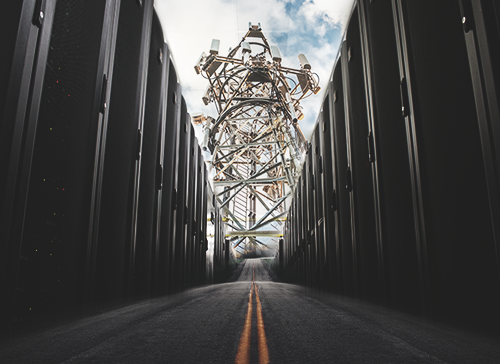
If 5G sparked a gold rush for edge data centers, 6G is set to redraw the entire map. While we’re still years away from full deployment (industry consensus points to around 2030), the conversations are already happening in boardrooms, labs, and policy circles. For enterprises, now is the time to understand how the next generation of wireless connectivity will change not just mobile networks, but the very infrastructure that powers them.
What 6G Promises
6G isn’t just a faster version of 5G. Early research suggests we’ll see:
-
Terabit-per-second speeds: A leap forward from today’s gigabit-class 5G connections.
-
Ultra-low latency: Sub-millisecond response times, pushing real-time communication into near-instant territory.
-
Massive device density: Supporting billions of sensors, IoT devices, and endpoints simultaneously.
-
Native AI integration: Intelligent networking that adjusts traffic flows, predicts congestion, and self-optimizes on the fly.
This combination opens the door for applications that feel like science fiction today: holographic communications, tactile internet (where you can “feel” remote interactions), autonomous transportation at scale, and industrial systems that operate in real time.
Why Edge Data Centers Become Critical
All of that futuristic potential depends on something decidedly physical: proximity. Terabit speeds and millisecond latencies are meaningless if data has to travel across continents. To make 6G’s promise real, compute and storage need to live right next to end-users and devices. That’s where edge data centers step in.
Edge facilities are designed to process and analyze data locally before handing only what’s necessary back to core clouds or centralized data centers. With 6G, that model becomes non-negotiable. Expect demand for:
-
Micro and modular data centers at cell towers, campuses, and city blocks.
-
Regional edge hubs (like HostDime’s hyper edge facilities) positioned within a few miles of enterprises and end-users.
-
Dense interconnection points where local, national, and cloud networks meet for instant routing.
Preparing Today for 6G Tomorrow
Even though 6G won’t arrive overnight, the groundwork must be laid today:
-
High-density power and cooling: Future hardware supporting 6G workloads will demand more power per rack than ever before.
-
Fiber-rich interconnection: Direct, redundant paths to carriers, cloud providers, and IXPs to minimize network hops.
-
Sustainability by design: Terabit speeds will consume enormous energy; data centers that excel in low PUE and renewable integration will be the ones ready to scale.
-
Global presence: Enterprises will need infrastructure in multiple regions to comply with local data laws and meet user demands for real-time access.
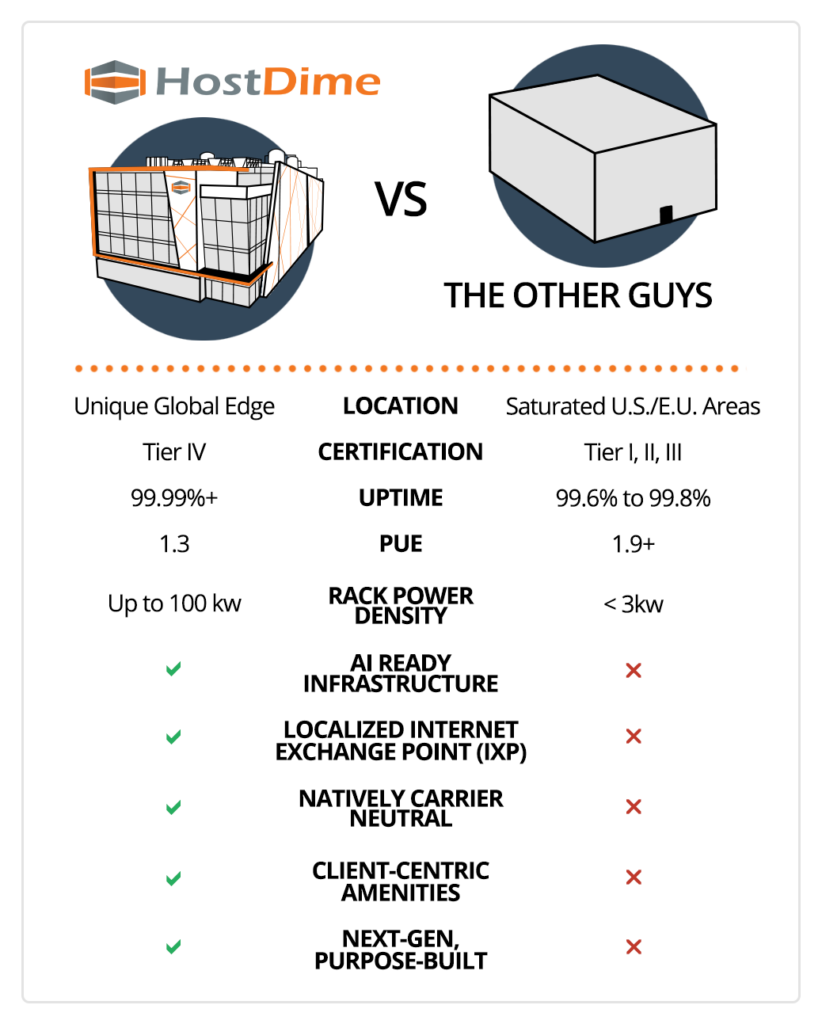
HostDime’s Role in the 6G Future
HostDime has been building for this edge-first world long before 6G was in the headlines. Our next-gen, purpose-built data centers are engineered for ultra-low latency, with Tier IV designs, renewable energy integration, and high-density capabilities that prepare enterprises for what’s next. From Orlando to Guadalajara to Bogotá and beyond, we’re creating the hyper edge ecosystem that future wireless innovation will depend on.
6G is a wholesale reimagining of digital infrastructure. For enterprises, the takeaway is clear: you don’t wait until 2030 to plan. The investments you make today in edge data center strategy, interconnection, and sustainable infrastructure will determine whether you’re ready when 6G moves from roadmap to reality.
Ready to explore how edge data center services can prepare your enterprise for 6G? Chat with our Data Center Infrastructure Specialists today!
The post The Road to 6G is Paved with Edge Data Centers appeared first on HostDime Blog.
HostDime Developing Next-Gen, Purpose-Built Data Centers at the Global Edge 13 Aug 7:20 AM (2 months ago)
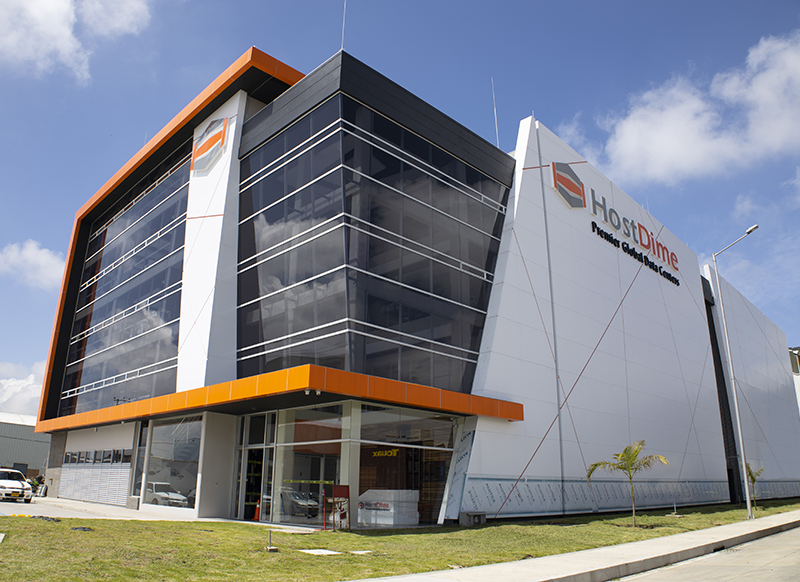
What’s the purpose of purpose-built data centers? A purpose-built data center is designed and developed from the ground up for specific mission-critical data center operations.
Most data centers today are retrofitted buildings, meaning they were large warehouses, factories, or commercial buildings that have been converted into a data center. They were built in the 1990’s telecom era where they were designed for a completely different era and use; those designs did not take into account multi-cloud, hybrid-cloud, public cloud, or private cloud architecture, nor the evolution of interconnection, peering, and Internet Exchanges (IX’s) that powers todays internet growth.
These makeshift data centers compromise on crucial infrastructure that puts customers’ businesses and their data at risk; they build infrastructure around what is already there, rather than where it should be. Conversely, when a data center is built from scratch, it is specifically designed and engineered to provide maximum uptime, security, and usability. This is where we see a need and have embarked on designing, building, and operating these world class facilities in what we call “global edge” locations.
This article highlights specific differences between next-gen, purpose-built data centers and typical retrofitted facilities, and provides examples on how we’re building these data centers for the needs of modern day consumption and the evolving technology landscape.
Purpose-Built Data Centers vs Retrofitted Facilities

Location Matters – One of the most important considerations for our selection of data center construction is location. Most current data centers reside in large common metropolitan areas in the US and Europe. Our strategic approach is to select emerging markets that lack the necessary data center infrastructure in the country. Usually network traffic in these areas “boomerang” back to the US or Europe to serve content, adding significant latency.
Equally, data has continued to be in demand in edge locations, to get as close to the end user as possible. We carefully do site selection in areas with high fiber connectivity to be able to handle large data throughput demands in the country and connect to the subsea cables that go directly to the global network backbone carriers. It is just a matter of time until most data will need to be localized in their respective countries to decrease latency and increase performance to its nationals.
We have been a pioneer in building these data center facilities in global edge locations. Going into these emerging markets isn’t easy, but we have feet on the ground, key relationships with local governments, and market intel collected over many years. With the ever-evolving need of localized data, HostDime is positioned to serve mission-critical infrastructure in these locations for decades to come. Our goal is to continue to build out our global footprint with a current focus on Latin America.
In terms of redundancy, a Tier IV facility typically features 2(N+1) Redundancy. This means that the facility has double what is required to operate, plus backup infrastructure. This is another reason why these types of data centers rarely have downtime because of failover redundancy to alternative systems within the infrastructure.
Most of the data centers today are Tier II and Tier III. Less than 20% of data centers in the world are Tier IV and we only build Tier IV as a standard and aim to achieve 100% uptime year after year. We don’t compromise on our investment, nor see any value in designing anything other than Tier IV to delivery trustworthy mission-critical infrastructure.
HostDime’s newest data center in Bogota, Colombia is the largest Tier IV data center in LATAM at nearly 70,0000 sq. feet.
PUE – PUE stands for Power Usage Effectiveness and it describes the efficiency of how a data center uses energy. The PUE is specifically the ratio of total energy delivered to computing equipment. A quick example is if a facility uses 100,000 kW of total power of which 80,000 kW is used to power your IT equipment, this would equal a PUE of 1.25. The lower the PUE, the better. Our purposeful use of the latest power efficient electrical components, modular POD foot prints, hot aisle containment, highest efficiency chillers, and renewable energy use all correspond to a large reduction in annualized PUE. We achieve a 1.3 PUE in our constructed data centers, while our competitors often have PUE in the 1.9 or higher range.
Rack Power Density and Redundancy – In the aforementioned 90’s telecom days, 2 to 4 kW per rack power density was considered high density because compute available in the market packed into equipment was relatively low. Nowadays, the average power consumption for a rack is around 6 kW depending on data application use. All of our purpose-built data centers feature dual distribution paths that provide power feeds to all racks and white space via A/B power sources by default, while allowing high-density racks up to 20 KW per rack on demand. Aisle containment is preinstalled on all data halls with racks, and available for setup to all other white space to properly and efficiently deliver the cooling necessary to support the power density designed for the space. High performance computing (HPC) continues to push the boundaries in compute and power consumption, which is something we keep in mind during the design process.
AI Ready Infrastructure – Artificial intelligence computing workloads present unique challenges beyond standard enterprise demands. Deep learning models and large-scale neural networks require extreme rack power densities to support the GPUs, TPUs, and other specialized processors that drive them. To handle these workloads, HostDime’s AI-ready facilities integrate infrastructure designed specifically for parallel processing at scale. This includes low-latency, high-bandwidth connectivity with enough fiber capacity for over 100 carriers, enabling rapid data exchange for real-time AI applications. On the cooling front, we go beyond traditional air-based methods with immersive and direct-to-chip liquid cooling systems. These solutions keep AI hardware operating at peak performance, preventing throttling and reducing energy waste. Purpose-built for the AI era, these capabilities allow clients to deploy advanced models, run real-time analytics, and scale AI operations without compromise.
Localized Internet Exchange Points (IXPs) – In a perfect world, Internet traffic would flow in the most direct route, point A to point B. Unfortunately, data usually leaves the country or second tier market cities, and sometimes even the continent, before it reaches its final destination. This Internet network behavior is very common in emerging markets where data center infrastructure is lacking. There is no local “ecosystem” to interconnect and peer, thus traffic must go long haul for interconnection. This “boomerang” effect unfortunately leaves end users with poor network performance and increased latency. At HostDime, with our vision to build the next-gen purpose-built Tier IV data centers platform, we play a major role in helping network traffic go more direct and stay within the country, instead of backhauling from faraway destinations. As we build this data center platform globally, we foster localized in-country interconnection and Internet Exchanges Points to ensure local Internet traffic is kept within the local country network; this yields better latency, stability, efficiency, and quality, all at a lower cost. IXPs and interconnection also make it easier for major global networks, cloud providers, and content providers to peer with each other within the country where they may not have otherwise been a presence. Ultimately, this all contributes to a more powerful and prosperous local economy. We are very driven by the impact and purpose our data centers will have, one country at a time.
Natively Carrier Neutral – Since our inception, HostDime has been a carrier neutral facility operator, meaning we don’t cater to a specific fiber/telecom company and welcome everyone to make a network presence in our facilities. Most older generation data centers are owned by telecom companies, where they have higher interest in offering their own network services. The market has continued and will continue to move to interconnection and peering. With the ever growing needs of applications and cloud providers connecting with others, this removes layers and hops to each other, increasing performance and minimizes latency. Everyone wins with this model because you can connect with whomever. We designed these facilities to be the home of interconnection; it’s like the party everyone will want to be at! We also make sure to design 4-6 manhole entries into our facilities to ensure enough redundancy and capacity to provide entry to countless carriers.
HostDime is currently building a second carrier neutral facility in Guadalajara, Mexico data center; our current 20,000 square feet facility is at 80% capacity, so a new purpose built facility is being constructed, slated to open in 2026. Read here for more information on this upcoming Tier IV data center.
Client-Centric Amenities – One last critical advantage of our vision in next-gen, purpose-built data centers is a focus on client amenities. Some amenities that are sometimes ignored in retrofits include client reception areas, on-site office areas for business continuity, IT equipment staging areas, collaboration conference rooms, multiple loading docks for IT equipment delivery, and on-site workstations. These are just some of the amenities that were not thought about just 20 years ago that help enable a modern day multi-cloud adoption.
If all that wasn’t enough, we have taken client amenities to the next level with our upcoming headquarters and flagship Orlando data center. Clients can take full advantage of on-site executive co-working offices, including full bathrooms, showers, and a full-sized gym, which we believe to be an industry first. The ability to do more within the data center and not just “work” is something we are excited about. HostDime’s flagship facility will also have a 350 person indoor-outdoor event space on the top floor of the facility to host technology related conventions and seminars in Central Florida.
What’s Next? – HostDime’s near term roadmap includes a continued focus on Latin America with purpose-built facilities coming to the following:
- Lima, Peru
- Guayaquil, Ecuador
- Buenos Aires, Argentina
- La Paz, Bolivia
- Bangalore, India
HostDime is looking at various land lots in Peru and Argentina presently, and hope to secure those lots later this year.
About HostDime
HostDime is a hyper edge global data center company operating our owned purpose-built public data center facilities in Mexico, Brazil, Colombia, and our flagship facility in Florida, USA, and with owned networks in the U.K. and India. Our mission is to design, build, and operate purpose-built, next-gen data center facilities at the global edge.
We offer an array of core digital infrastructure products and services including colocation (private data center suites, cages, racks), interconnection (cross-connects, peering, transit), Hardware-as-a-Service (bare metal servers, lease-to-own servers, hardware procurement), cloud infrastructure (private, hybrid, multi-cloud), and managed services (server management, remote hands, smart hands).
The post HostDime Developing Next-Gen, Purpose-Built Data Centers at the Global Edge appeared first on HostDime Blog.
DDoS Attacks, Bot Traffic Jump in First Half of 2025, Here’s How to Stop It 11 Aug 7:53 AM (2 months ago)
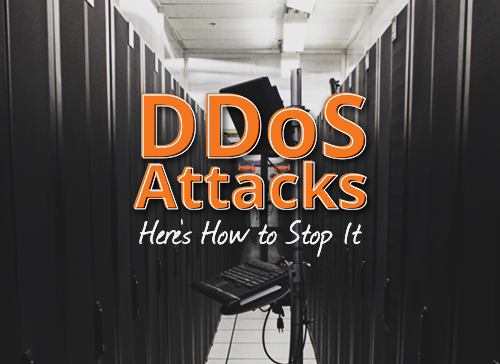
The threat landscape in 2025 is evolving faster than ever, and Distributed Denial of Service (DDoS) attacks remain a top concern. Radware’s latest report for the first half of the year shows sharp increases across nearly every attack vector: web DDoS attacks jumped 54% quarter-over-quarter, bad bot traffic spiked 57%, and claimed hacktivist DDoS campaigns rose 62% year-over-year. Smaller, persistent DDoS campaigns—often under 100,000 requests per second—are on the rise, while peak attacks still reach more than 10 million RPS. Application-layer exploitation is nearing record levels, adding yet another layer of complexity for defenders.
These attacks are becoming more surgical and coordinated, fueled by freely available toolkits, generative AI, and organized hacktivist groups operating on platforms like Telegram. Network-level floods (L3/L4) surged 85.5% over late 2024, with the average customer now facing over 7,200 mitigations per quarter—a 485% increase in just five years. All indicators point toward continued growth and intensification of these trends, making proactive, multi-layered DDoS protection more critical than ever.
The True Cost of a DDoS Attack
The cost of disruption remains staggering: at an estimated $6,000 per minute, a 10-minute outage can quickly rack up $234,000 in direct losses, not counting reputational damage and recovery expenses. Due to these attacks, customers face:
-
Lost revenue (e.g., eCommerce sites lose ~$10K/minute).
-
Regulatory fines for compliance failures (HIPAA, PCI DSS).
-
Long-term reputation damage—60% of SMBs fold within 6 months of a major breach.
DDoS Protection for Businesses is Now Imperative
Radware’s report not only sheds light on the increasing frequency and sophistication of DDoS attacks but also serves as a stark reminder of the tangible, devastating effects these attacks can have on businesses—effects that extend beyond immediate financial losses to include long-term reputational damage and operational disruptions.
DDoS protection for businesses is no longer an optional add-on but a fundamental component of a business’s cybersecurity posture. The reality is that the cost of implementing effective DDoS protection pales in comparison to the potential losses from a single attack, making it a wise and necessary investment for ensuring business continuity, protecting customer trust, and maintaining operational efficiency in an increasingly hostile digital environment.
HostDime’s DDoS Attack Mitigation Services
Now, bare metal server and colocation owners will have the ability to protect themselves better than ever thanks to HostDime’s secure network, which is among the most DDoS protected in the infrastructure industry. That’s because we offer three types of DDoS protection: NETSCOUT’s local inline mitigation, a cloud-based traffic scrubbing service, and a combination of the two.
HostDime’s Inline DDoS Protection
HostDime’s inline DDoS protection is a hardware-based monitoring and mitigation set-up situated directly within our data center. This inline approach filters out malicious traffic on-premises, allowing only legitimate traffic to reach your server. This method has significant advantages:
- Reduced Latency: Since the process is handled within the data center, there is no detour of traffic to external cleaning centers, ensuring end users experience no added latency.
- Enhanced Security: Keeping traffic within the data center eliminates the risk of interception or vulnerabilities that can arise when traffic is sent to third-party cleaning services.
- Intelligent Learning: HostDime’s hardware is designed to learn and adapt to “normal” traffic patterns for your server, improving its ability to distinguish between legitimate traffic and DDoS attacks.
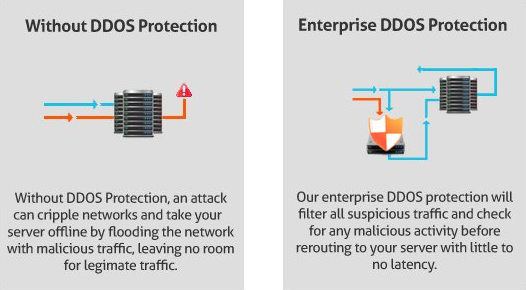
HostDime’s DDoS Cloud Scrubbing
In addition to inline mitigation, HostDime offers DDoS Cloud Scrubbing, an IP routing service where traffic is thoroughly examined and cleaned before being rerouted to the enterprise network via Generic Routing Encapsulation (GRE) tunnels. This process acts as a powerful safety net, ensuring that in the event of a large-scale DDoS attack, your critical infrastructure remains protected. The cloud scrubbing operates as a private point-to-point link, offering another layer of security and redundancy.
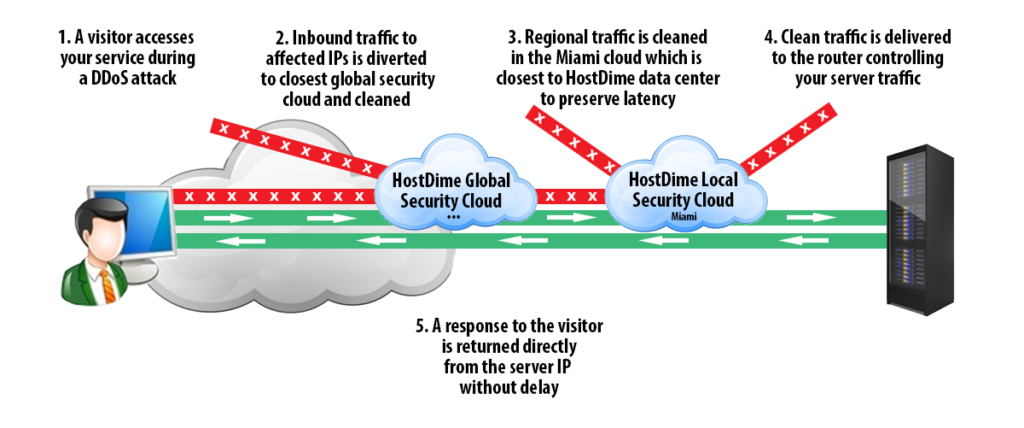
HostDime’s Hybrid DDoS Protection
Lastly, for businesses looking for comprehensive coverage, HostDime provides Hybrid DDoS Protection, combining the best aspects of inline hardware protection with the added security of cloud scrubbing. This setup ensures immediate detection and mitigation of both large and complex DDoS attacks, with the cloud scrubbing ensuring that clean traffic continues to reach your site even under attack.
Don’t Wait Until It Happens
With attack frequency nearly doubling, and AI making threats smarter, the question isn’t if your business will be targeted—it’s when. HostDime’s purpose-built data centers and always-on mitigation solutions are designed to protect mission-critical operations and ensure uptime, even under attack.
Talk to our team today to build a DDoS defense strategy that fits your risk tolerance and business needs.
The post DDoS Attacks, Bot Traffic Jump in First Half of 2025, Here’s How to Stop It appeared first on HostDime Blog.
The 5G Edge Gold Rush: Why Location Beats Hyperscale 6 Aug 9:01 AM (2 months ago)
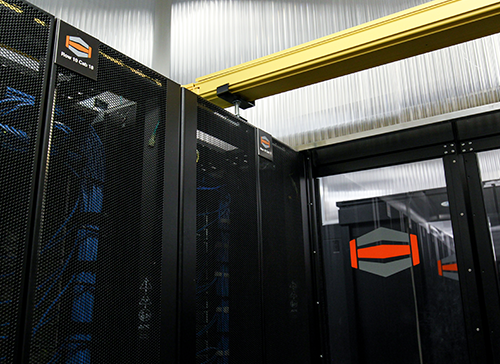
A fresh gold rush is underway. Only instead of panning in dusty streams, businesses are racing to deploy workloads inside edge data centers located just miles from their customers. These purpose-built facilities, designed for 5G edge computing, deliver sub-10 millisecond response times that hyperscale cloud regions simply cannot match. By year’s end, it’s estimated 75% of enterprise-generated data will be created and processed outside traditional data centers or centralized clouds.
From real-time analytics and immersive gaming to AI-powered automation and IoT control, modern applications require infrastructure that is close to the action. The edge is no longer a trend. It is the foundation for next-generation performance.
Why Edge Data Center Services Are in Demand
5G has redefined what users expect from digital experiences. It delivers lightning-fast wireless speeds, but unless your compute lives nearby, performance still lags. Edge data center services bring processing power into the same metro area as your users, dramatically reducing latency and improving service delivery.
Here’s how edge colocation meets today’s performance needs:
-
Cloud Gaming and XR: Hosting game engines and virtual rendering at the edge ensures smooth, responsive visuals with frame delivery under 30 milliseconds.
-
IoT Infrastructure: Billions of devices rely on real-time decisions. Local processing filters and reacts instantly, sending only essential data back to the core cloud.
-
AI and Machine Learning: Inference engines placed near intersections, factories, or cameras allow models to respond instantly to changing inputs.
-
Smart Cities and Automation: Whether optimizing traffic flow or managing utilities, on-the-spot analytics cut costs and increase safety.
The closer your workloads are to users, the better your applications perform.
HostDime: Your Edge Data Center Services Partner
HostDime has spent over 20 years designing and operating next-generation data centers for emerging workloads. Our edge data centers in Orlando, Bogota, Guadalajara, João Pessoa, and other strategic locations keep your infrastructure within 25 miles of major population centers. This proximity is the key to delivering low-latency, high-performance experiences.
Our edge colocation services are built to give your applications an advantage:
- Proximity to End Users: Our facilities in high-growth metros put your workloads close to tens of millions of people. Local hosting reduces latency and improves user experience across the board.
- Carrier-Neutral Interconnection: With direct access to Internet Exchanges, traffic is routed locally. This minimizes middle-mile delays and cuts backhaul costs while maintaining reliability.
- Infrastructure Built for 5G and AI: HostDime’s data centers feature high-density power, liquid-ready cooling systems, and modular design. These facilities support AI clusters, GPU deployments, and bandwidth-hungry applications with ease.
- Real-Time Processing at the Source: When infrastructure is placed at the edge, data can be acted on immediately. Whether analyzing live video feeds or managing critical automation systems, edge-first designs keep decision-making fast and accurate.
- Proven Uptime and Support: With 99.999 percent uptime and around-the-clock support from bilingual, on-site engineers, HostDime provides the reliability that mission-critical workloads demand.
Bring Your Workloads to the Edge
The cloud is no longer enough. Edge data center services are the key to enabling real-time applications that demand speed and reliability. HostDime’s global edge network gives you the location, the infrastructure, and the expertise to compete in today’s latency-sensitive landscape.
Let’s build your edge presence together. Your future-ready infrastructure is closer than you think.
Book a tour or consultation
Email: sales@hostdime.com
Call: +1 407-756-1126
The post The 5G Edge Gold Rush: Why Location Beats Hyperscale appeared first on HostDime Blog.
Edge Colocation by HostDime | Low-Latency, High-Density Power 23 Jul 8:41 AM (3 months ago)
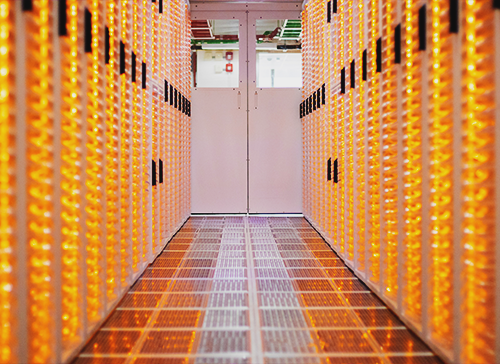
Edge Colocation: Put Your Data Within Milliseconds of Your Users
Edge traffic is booming, and the numbers don’t lie. Global edge data center revenue is projected to jump from $7.2 billion in 2021 to $19.1 billion by 2026, with edge servers expected to handle half of all telecom workloads by the same year. In a world where every millisecond counts, legacy infrastructure just can’t keep up.
Why “Good Enough” Data Centers Are No Longer Good Enough
Edge hungry apps, AI models, and IoT sensors will push the edge data center market past $317 billion by 2026; that’s more than double its 2020 size. Yet most facilities serving that demand still live inside 1990s warehouses that were never meant to power 20 kW-plus racks or route traffic locally. Three cracks are already showing:
- Latency kills revenue. Just 100 milliseconds of delay can reduce online conversions by 7 percent. When data has to travel across the country or even farther, it slows down interactive services like gaming, fintech, AI, and streaming.
- Inefficiency drains budgets. The global average PUE is 1.56, meaning nearly half of all energy never reaches your IT hardware. Retrofitted cooling paths and mismatched power trains keep that number stubbornly high.
- Power Density Is Maxed Out. Modern AI and GPU-driven workloads require 30 to 100 kW per rack, but retrofitted data centers often top out at 4 to 6 kW. That leads to scattered deployments, higher costs, and wasted space.
Compare HostDime to Legacy Operators
Our edge colocation data centers are not conversions or upgrades. They are purpose-built, Tier IV facilities created to meet the demands of today and tomorrow. From design to deployment, everything is built to perform at the highest level.
| HostDime Purpose-Built Tier IV Edge Campus | Typical Retrofitted Warehouse |
|---|---|
| Built from the ground up for modern power, cooling, and interconnection | Infrastructure shoe-horned into 1990s shells |
| Tier IV, 2 N + 1 redundancy; < 26 minutes downtime per year | Mostly Tier II–III, single power path |
| PUE around 1.3 thanks to hot-aisle containment and high-efficiency chillers | PUE 1.9 + common, higher OPEX |
| A/B power to every rack; 20 kW standard, up to 100 kW for AI/HPC | 4–6 kW typical, rarely > 30 kW |
| On-site IXPs & carrier-neutral meet-me rooms; 4-6 diverse fiber entrances | Single incumbent carrier, traffic boomerangs offshore |
| Client-centric amenities: staging rooms, co-working suites, 100G Internet | Limited desks, no continuity spaces |
Reserve Your Edge Colocation Space Now
We don’t lease space from others. We own and operate our edge data centers from the ground up, giving us full control over performance, uptime, and service. Our locations are chosen carefully to reduce latency and keep workloads local, closer to users and markets. Less than 1 percent of the world’s data centers are Tier IV. HostDime builds nothing else.
Be part of the next generation of digital infrastructure. Bring your workloads home to the edge. Reserve your rack or private suite before the Orlando grand opening in late 2025!
The post Edge Colocation by HostDime | Low-Latency, High-Density Power appeared first on HostDime Blog.
How HostDime Delivers Scalable Data Center Cooling Solutions 9 Jul 12:16 PM (3 months ago)
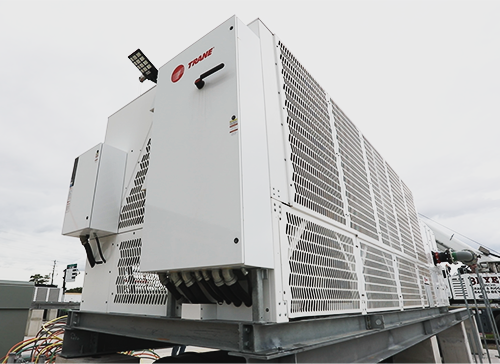
AI training clusters, GPU-packed private clouds, and edge workloads are pushing today’s data centers to their thermal limits. These modern deployments can generate five to ten times more heat than legacy infrastructure, and analysts expect average rack densities to double again within the next three years. At HostDime, we saw this coming. That’s why we’ve standardized on Trane’s enterprise-grade data center cooling solutions across all of our global facilities, delivering consistent, energy-efficient performance from Orlando to Mexico, Colombia, and Brazil.
Our upcoming Orlando headquarters, codename SuperNova, sets a new standard for next-generation cooling and is designed to support the compute-intensive demands of AI/ML/HPC workloads for years to come.
Why Trane Anchors the HostDime Platform
| Advantage | What it means for your business |
|---|---|
| Oil-free, variable-speed centrifugal compressors | Lower power draw, whisper-quiet 72 dB operation, minimal wear and tear. |
| High-ambient design up to 125 °F | Reliable uptime in Florida summers, tropical Brazil, or high-altitude Colombia. |
| Same hardware across four countries | Predictable spares, uniform SLAs, and seamless multi-site expansion. |
| Native BACnet IP telemetry | Real-time temperature, kW, and alarms in HostDime DCIM and your BMS. |
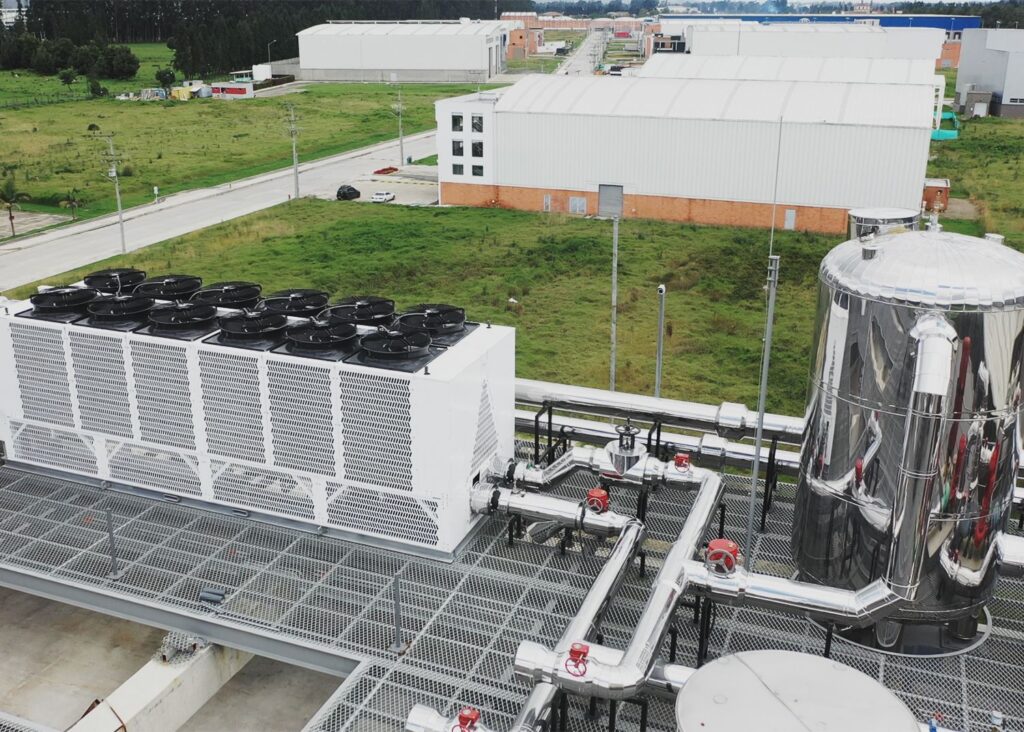
Inside SuperNova: Future-Ready, Florida-Tough
SuperNova’s thermal plant is purpose-built for today’s workloads… and tomorrow’s. It features a 660-ton Trane chiller plant, built to deliver unmatched reliability, efficiency, and scale.
| Feature | Business Benefit |
|---|---|
| Three 220-ton ACA200 air-cooled chillers (N+1) | Ensures cooling availability even during maintenance windows |
| Dedicated refrigerant circuits per compressor | Isolates faults without disrupting the whole system |
| Magnetic bearings | Reduces friction, noise, and mechanical failures |
| Variable-speed 910 mm condenser fans & pumps | Adjusts cooling dynamically based on real-time load, reducing PUE |
| Touchscreen PLC & setpoint control | Engineers can fine-tune settings without taking systems offline |
| Dual power disconnects (UPS + Utility) | Keeps critical components operational during outages or transitions |
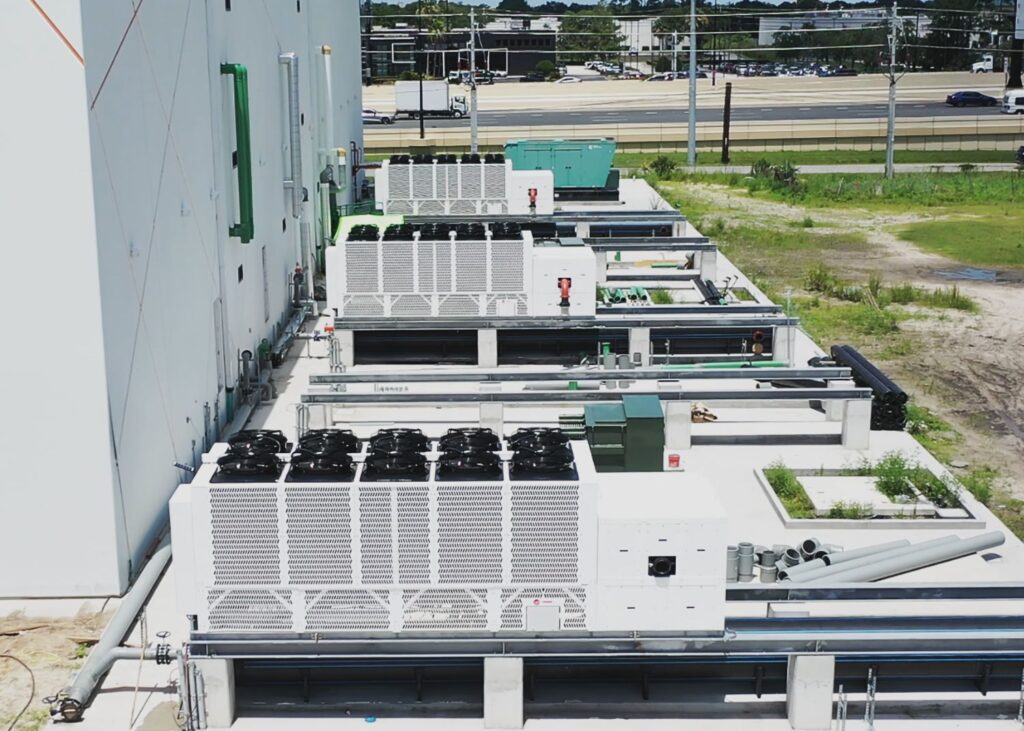
These data center cooling solutions deliver scalable support for 30 kW racks today and up to 50 kW air-cooled racks tomorrow and are built to evolve with demand.
Sustainability and Cost Control
At HostDime, high performance doesn’t come at the cost of sustainability or operating expenses.
-
Energy Efficiency: Variable-speed drives and oil-free compressors cut energy use by up to 30% over traditional systems.
-
Water-Free Cooling: Our air-cooled design avoids water waste and the chemicals required in evaporative systems.
-
Smarter Maintenance: Predictive diagnostics monitor vibration and temperature 24/7, alerting our team before small issues become downtime risks.
What Decision-Makers Can Expect
| Priority | How HostDime Delivers |
|---|---|
| OPEX Reduction | More efficient systems, fewer service calls, lower total cost of ownership |
| Uptime Assurance | 99.999% uptime featuring N+1 redundancy and failover power |
| Sustainability & ESG | Precise energy usage metrics and a low-water footprint for green reporting |
| Growth-Ready Infrastructure | SuperNova is piped and power-ready for direct-to-chip liquid cooling, giving you a seamless path to 100 kW+ racks without retrofits |
Ready to See It for Yourself?
SuperNova isn’t just HostDime’s newest facility, it’s your launchpad for high-density, AI-ready infrastructure in a region built to scale. For prospective clients, reach out today to schedule a firsthand look at SuperNova.
Call: +1 407-756-1126
Email: sales@hostdime.com
Address: 1 Innovative Place, Maitland, FL 32751
The post How HostDime Delivers Scalable Data Center Cooling Solutions appeared first on HostDime Blog.